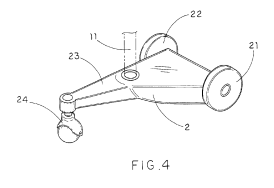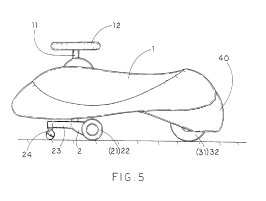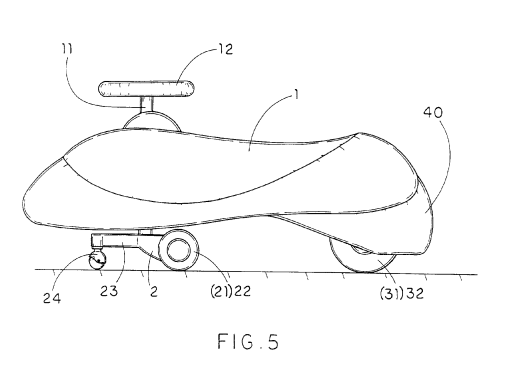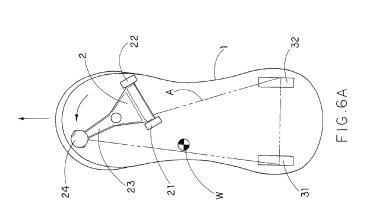W&G 674特許の図4
図5:


|
PlaSmart v. USPTO
and WANG & GU (W&G) 2011-1570 Federal Circuit May 22, 2012 PTO審判部の自明性判断に対するCAFCの審理の仕方
Summarized by Tatsuo YABE October 19, 2012 |
本事件は、当事者系再審査後の審決(W&Gの米国特許6722674のクレームは有効)を不服とした当事者系再審査請求人PlaSmartによる控訴審の判断である。 審判部においてはクレーム1と20−33の全ての特許性が認められたが、CAFCで逆転判決となり、全てのクレームが自明であり無効と判断された。 この判決は、審判部による審決をCAFCがどのような基準で判断するかに対するガイダンスを示す(勿論、先例となるものではない)ものである。また、発明が非常にシンプルな構造なので、クレームをどのように補正すれば非自明(被疑侵害者の形態を権利範囲に維持した状態のまま)の主張が維持されていたかのディスカッションの題材になると考えます。
+++++++++++++++++++++++++++++++++++++++++++++++++++
CAFC判事: Lourie判事、Dyk判事、Moore判事
原告: PLASMART,
INC., (当事者系再審査請求人)
被告: Kappos
(Director) of USPTO and Jar Chen WANG & Hong-Jiun GU (以下W&Gと称する)
控訴理由:(控訴に至る経緯)
PlaSmart
は、当事者系再審査後の審判部の判断(審決:W&GのUSP674特許クレーム1,
20−33の特許性を認めるという)を不服とし、CAFCに控訴した。
CAFC判決: 判決原文こちら
審決を破棄する。 W&Gのクレーム1はSong引例に鑑みHandong引例によって自明である。クレーム20-33はクレーム1にさしたる特徴を追加するものではないので同理由によって自明である。
+++++++++++++++++++++++++++++++++++++++++++++++++++
以下判決の要旨とディスカッション
本事件で問題となったW&Gの特許は子供用の自走式スクーターに関し、ハンドルを左右にツイストすることで自走するもので、斜面の凹凸などに起因し、前方に転倒するというトラブルを防ぐためにツイスター機構の前部に車輪24を設けたというのが特徴であり、一旦は審判部で特許性が認められたもののCAFCで審決が破棄された。
W&G
674特許クレーム1の特徴:
(*1を参照)
子供用スクーターの前転倒を防ぐために、ツイストメンバー2の前方に延設する支持アーム23の前端部に安全車輪24が取り付けられている。
|
W&G 674特許の図4 |
図5: |
|
|
|
|
|
|
まず、CAFCにおける審決の判断基準は、審判部の事実認定に関しては十分な証拠でサポートされているか(Substantial
Evidence)という基準であり、審判部の自明性に対する最終判断に対しては審判部の判断を一からレビューするという
de novo基準である。 今回CAFCも繰り返していますが、自明性の判断はGrahamファクター(4要件:1.引例の開示内容と範囲; 2.当業者のレベル、3.引例とクレームされた発明との差異; 4. 客観的証拠)の事実の認定に基づく法的判断事項であり、引例を組み合わせて拒絶することが妥当であるか否かの判断はKSR事件の判決に基づくものである。
|
Song引例(以下代表図) Chinese
Pat App. 89211060.0 |
Handong引例(以下代表図) Chinese Pat
Publication CN 3114939D |
|
|
|
|
24は実は2つの車輪; 当該一対の車輪24は、前車輪16と後車輪1が共に地表に接触している状態においてフラットな地表とは接触状態にはない。 |
|
CAFCは審判部が認めた非自明性の根拠である事実(Grahamファクターの第3要件であるクレームと引例との差異、即ち、Song引例における安全車輪24の取付位置は、674特許クレーム1のツイスト支持アーム23の前方位置ではない★)が軽微なもの(miner
distinction)であり、転倒防止のために、スクーターの本体ではなく、ツイスト支持アームに取り付けるという設計変更は一般常識の範囲(common
sense alternative design choice)であるという簡単な理由付けで片付けており、また、クレーム1には規定されていない特徴、安全車輪24が地面に設置している、という特徴もSong引例との差異(クレーム1では言及していない)をあたかもクレームの要素であるかのように説示している。
The
board, in reversing the examiner’s rejections, relied only on minor distinctions
between the prior art and the claimed invention.
Handong shows all the limitations of claim 1 of the ‘674 patent except
the safety driving equipment, which is not disputed on appeal.
The Board agreed with the examiner that Song discloses a reason for
adding universal wheels (the safety driving equipment in Song) to Handong’s
scooter, but then held that because Song does not place those universal wheels
in the exact location as the ‘674 patent, it cannot render claim 1 obvious.
But such a distinction reads the teaching of Song too narrowly.
Song
discloses a safely feature, namely, using universal stabilizing wheels on the
ground all the time, the safety disclosure in Song is that an additional wheel
placed in front of the twister member provides additional stability in the
direction of movement when in contact with the ground, which …
The decision to attach the Song safety wheel directly to the twister member
instead of the body would have been a common sense
alternative design
choice ….
Such a modification is nothing more than a predictable use of prior use
of prior art elements (universal wheels in contact with the ground in front of
the twister member) to address a known problem (stability), and would thus have
been obvious. (emphasis added)
W&Gは「安全車輪24が、前輪と後輪とともに地面に当接する」という特徴を再審査中に、クレーム1に追加することでSong引例とHandong引例の組み合わせによる差異をより明白にすることが可能であったと思われるが、そのような補正をするとFesto禁反言が作動し、PlaSmartの製品(*2を参照)が権利範囲から明瞭に除外されるため、そのような補正はできなかったのであろう。
上記審判部が認めた事実(引例との差異★)がCAFCが指摘する軽微なもの(miner distinction)であったか否か(即ち、非自明性を結論づけるレベルか否か)の判断は法律問題なので、CAFCがde
novoで判断できるのは正しい。 しかし、審決を覆すにはそれ相応の理由を説示する必要があったのではなかろうか?
例えば、上記審判部が認めた差異(★)によって、674特許の安全車輪24は舵取りハンドル12に直結されたツイストメンバー2の揺動と連動することにより、674特許図6A,6B(*3参照)で見られるように、進行方向に対して左右に安全車輪24がスイングする。 この安全車輪24の左右方向へのスイングモーションによる利点(効果)をW&Gは説明できなかったのか? 或いはその効果を説明しようとすると安全車輪24が常に地面に設置しているという特徴を言及する(即ちPlaSmartの製品を非侵害とする)必要があったのか?
今回の判決文においては、発明当時において、Song引例とHangdon引例とを組み合わせることに対する何らかの理由(動機付け)があったのかという事実問題に関しては一切言及されていない。また、引例同士を組み合わせる漠然とした動機付けが仮にあったとしても、重要なのは、クレームの構成要素を現出するに至らしめるような組み合わせに対する動機付けが存在していたのかが問題であり、当該動機付けに対して審判部が判断をしていたのであれば、その判断は事実判断であり、Substantial
Evidence基準でCAFCは判断するべきである。 この点に関して今回の判決文では一切言及されていない。
自明性判断基準として、Grahamファクター(事実問題)と、当該Grahamファクターの事実認定に基づき自明性を最終判断(法律問題)するという基本が判例法で確立しており、その中間地点として、引例を組み合わせる理由の存在の判断は事実問題であるという基準が後の判例(Transocean
Offshore Deepwater Drilling, Inc. v. Maersk Contractor USA Inc
(Fed Cir 2010) (citing McGinley v. Franklin Sports,
Inc. (Fed Cir. 2001) *4) によって確立していると思料する。 然しながら、今回の判決文においてはGrahamファクターに対する審判部の認定を認めるものの、審判部が認めた引例とクレームとの差異(★)を軽微(miner
distinctions)なもの、及び、そのような設計変更は一般常識(common
sense alternative design choice)とde novo審理で片付けた今回のCAFC判決は杜撰であったと考える。
+++++++++++++++++++++++++++++++++++++++++++++++++++
(*1)問題となった特許とクレーム:
USP
6,722,674 (674 特許) – Apparatus Claim
1
1. A scooter, comprising:
a
scooter body;
a
pair of rear wheels rotatably supported at a rear portion of said scooter body;
a transmission unit having an upper control portion positioned above said
scooter body and a lower connecting portion extended underneath said scooter
body; a steering means affixed to said control portion of said transmission unit
for driving said connecting portion thereof to rotate in clockwise and
anti-clockwise directions;
a
twister member having a driven portion connected to said connecting portion of
said transmission unit;
a
pair of driving wheels spacedly and rotatably mounted to said twister member
wherein said two driving wheels are spaced apart from said driven portion of
said twister member; and
a
safety driving equipment, comprising:
a
supporting arm (23) frontwardly extended from said driven portion of said
twister member (2);
and
a
safety wheel (24)which is rotatably mounted to a free end of said supporting arm
(2) to support a front portion of said scooter body and prevent said scooter
from being flipped over.
(emphasis
and ref.
No. added)

(*2) PlaSmartの製品
(安全車輪が路面より浮いているのが見られる。 下図の左側スクーターの車輪を見ると理解しやすい)

(*3)W&G’s USP674の図6A

*4)
McGinley v. Franklin Sports, Inc. (Fed Cir. 2001)
Whether a motivation to combine prior art references has been
demonstrated is a question of fact. Winner
Int'l Royalty Corp. v. Wang, 202 F.3d 1340, 1348, 53 USPQ2d 1580, 1586 (Fed.Cir.
2000) *2★).
The assessment of whether to combine references in a
given case has sometimes been viewed conceptually as a subset of the first Graham
factor, the scope and content of the prior art. See, e.g., id.; Monarch
Knitting Mach. Corp.v. Sulzer Morat Gmbh, 139 F.3d 877, 881-83, 886, 45
USPQ2d 1977, 1981-82, 1985 (Fed.Cir. 1998). Although that view is not
incorrect, accurate assessment of whether to combine references may require
attention to other Graham factors. For example, the level of skill in the
art may inform whether the artisan would find a suggestion to combine in the
teachings of an exemplar of prior art. Where the level of skill is high, one may
assume a keener appreciation of nuances taught by the prior art. Similarly,
appreciation of the differences between the claims in suit and the scope of
prior art references — a matter itself informed by the operative level of
skill in the art — informs the question of whether to combine prior art
references. At bottom, in each case the factual inquiry whether to 1352*1352
combine references must be thorough and searching.
Winner
Int'l Royalty Corp. v. Wang, 202 F.3d 1340, 1348, 53 USPQ2d 1580, 1586 (Fed.Cir.
2000)
There
is no question here that FSI presented sufficient evidence at trial from which a
jury could have decided that one of ordinary skill in this case would have been
motivated to combine Pratt and Morgan to produce a prima facie obvious
invention. Specifically, FSI argued to the jury that the only elements of the
asserted claims that are not clearly anticipated by Pratt are the finger-shaped
marks that orient the ball with respect to the palm of the user's hand.
Referring to the "phantom lines" in Pratt as suggestive of finger
placement on the ball, FSI argued that one of ordinary skill would have been
motivated to substitute the finger marks from the Morgan ball for the circular
marks on Pratt, or alternatively to place three sets of marks on the Morgan ball
in the light of Pratt's teachings. In addition, FSI argued that one of ordinary
skill would have known to add the finger orientation means of the Morgan patent
to Pratt by "filling in" the phantom lines in Pratt's drawings and
treating them as finger orientation means.
The
dispute here focuses on the combinability of the prior art. When an obviousness
determination is based on multiple prior art references, there must be a showing
of some "teaching, suggestion, or reason" to combine the references. Gambro
Lundia AB v. Baxter Healthcare Corp., 110 F.3d 1573, 1579, 42 USPQ2d 1378, 1383
(Fed.Cir.1997) (also noting that the "absence of such a suggestion to
combine is dispositive in an obviousness determination"). Whether
motivation to combine the references was shown we hold a question of fact. See
In
re Dembiczak, 175 F.3d 994, 1000, 50 USPQ2d 1614, 1617 (Fed.Cir.1999)
("[P]articular factual findings regarding the suggestion, teaching,
or motivation to combine serve a number of important purposes . . . .")
(emphasis added); Monarch
Knitting, 139 F.3d at 881-83, 886, 45 USPQ2d at 1982, 1985 (treating
motivation to combine issue as part of the scope and content of the prior art
and holding that genuine issues of fact existed as to whether one of
ordinary skill in the art would have been motivated to combine the references in
question).
Evidence
of a suggestion, teaching, or motivation to combine prior art references may
flow, inter alia, from the references themselves, the knowledge of one of
ordinary skill in the art, or from the nature of the problem to be solved. See
Dembiczak,
175 F.3d at 999, 50 USPQ2d at 1617. Although a reference need not expressly
teach that the disclosure contained therein should be combined with another, see
Motorola,
Inc. v. Interdigital Tech. Corp.,
121 F.3d 1461, 1472, 43 USPQ2d 1481, 1489 (Fed.Cir.1997),[6]
the showing of 1349*1349 combinability, in whatever form, must nevertheless be
"clear and particular." Dembiczak,
175 F.3d at 999, 50 USPQ2d at 1617.